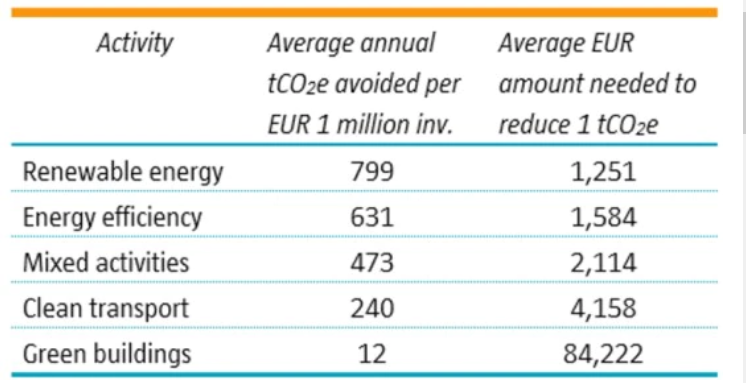Green bonds offer an opportunity to compare the environmental impact of a range of different green projects when using a standardized measure. We use the unit measure tCO2e avoided1 per million euros invested to evaluate the impact of green bond projects across sectors and regions. Our research finds that not all investments in green projects have the same impact: some are more efficient at reducing carbon emissions than others. Using this information, and applying the inverse of our unit measure, we are able to estimate how much capex is needed to achieve the goals of the Paris Agreement.2
Vast amounts of green funding needed
Extensive investments are needed to achieve the global ambitions of net zero carbon emissions by 2050. To put the scale of the funding that is needed to transform the world economy into perspective, the International Renewable Energy Agency (IRENA, 2021) estimates that USD 4.4 trillion must be invested annually by 2050 for a 1.5°C climate pathway. This is to finance projects with an abatement value of approximately 1.23 GtCO2e per year,3 including energy transition technologies (renewable energy, end-use electrification, hydrogen innovation) and carbon removal measures. This amount of investment will imply a cost of USD 3,550 per ton of CO2e reduced.
Accounting for the world’s largest asset class, the global fixed income market has a critical role to play in financing the transition to global net zero emissions. The rapidly growing green bond market will play a vital part in this.
Robeco’s fixed income team has been investing in green bonds since 2013 and uses its proprietary five-step green bond screening process to determine whether bonds truly are green. By the end of September 2021, Robeco’s investments in green bonds totaled approximately EUR 3 billion.
Impact reporting of green bonds provides useful information that allows us to assess green projects across sectors and regions from a carbon-abatement-efficiency perspective. We define this comparison as a ‘green impact premium’. This, in turn, enables us to assess the best approach to follow in funding the transition to a green economy.
Deriving a metric to assess green projects
We applied information from more than 440 green bond impact reports from 118 different issuers (from 26 countries and 13 different sectors), and calculated the avoided tons of CO2e emissions per million euros invested for each green bond.
Derived from green bonds, this metric allows investors to compare the climate change mitigation impact of green bonds and simplifies impact reporting for issuers as well as investors. Investors can aggregate the impact metrics of different bonds in their investment portfolios to obtain a portfolio-level impact indicator and, in this way, managers interested in the mitigation potential of their portfolios can use this indicator to select green bonds that are the most efficient from a carbon abatement perspective.
Renewable energy has the highest abatement efficiency
We find that the renewable energy generation sector is the best performer in terms of carbon efficiency. It contributes to avoiding, on average, 799 t CO2e per million euros invested. This result also implies an average cost of EUR 1,251 per ton of CO2e avoided, significantly below the average cost obtained from IRENA after adjusting for foreign exchange effects.
Figure 1 | Global: Average tons of CO₂e emissions avoided per million euros invested and average amounts of euros needed to reduce one ton of CO₂e

Source: Green bond impact reports of multiple issuers. As at October 2021
There were interesting regional differences in these findings. The abatement efficiency of renewable energy projects was higher for projects located in countries with carbon-intensive energy schemes. These projects avoided 78% more CO2e emissions than projects in Europe, implying an average capital cost of EUR 736 per ton of CO2e avoided, significantly below our estimate of the global average for the sector.
On average, projects related to green buildings produced the lowest level of greenhouse gas abatement compared to other types of projects: they facilitated the avoidance of 12 t CO2e per million euros invested. We believe there may be two reasons for this relative underperformance in abatement efficiency. First, the building sector is less expensive to decarbonize and has less abatement potential than other sectors. Secondly, there has been significant progress in improving the energy efficiency of buildings across countries, reducing the current cost differential between green buildings and traditional ones.
Low-carbon transportation projects, which include infrastructure for clean energy vehicles (electric, hydrogen, hybrid), public, rail, and multimodal transportation, are also shown to have high CO22 reduction potential, at 240 t CO2e per million euros invested. Within this category, we found that public transportation projects (passenger rail transport, tram) have higher abatement potential than passenger cars and light commercial vehicles (41 t CO2e per million euros invested).
The activity with the second-largest abatement potential is energy efficiency (smart grids, district heating, energy storage, heat pumps) with 631 t CO2e per million euros invested. It is expected that energy efficiency improvements will contribute 25% of the total mitigation needed to be aligned with a 1.5°C scenario (IRENA, 2021). One clear example is related to heat pumps, which can be powered by renewable electricity and achieve two to five times higher energy efficiency than fossil-fueled boilers.
Assessing the investment opportunity and its scale
Our findings suggest that the existing technology gap between green and traditional alternatives is smaller in the building sector than in the energy sector, which has implications for what investments should be targeted. In particular, sectors in which unabated emissions are higher and technology gaps still exist, such as the energy sector, should receive more abatement investment, to smooth their decarbonization pathway.
Considering the implicit costs of investing in renewable energy and energy-efficiency projects, such as in end-use electrification, power grids, etc., and using the information derived from the green bond impact reports, we can estimate the total value of investment needed to achieve net zero. Our calculations show that the world will need to invest EUR 121.7 trillion in these sectors by 2050. This represents an average annual fund requirement of EUR 4.1 trillion.
To achieve this, the annual capital expenditure in renewable power generation must multiply by 4.5 times, while energy efficiency capex must increase by 2.5 times.
Conclusion
Getting to a net zero outcome by 2050 is an ambitious target. It is also an attractive opportunity for investors: our estimates, based on impact reporting within the green bond market, suggest that EUR 121.7 trillion of capex spending is needed in renewable energy and energy-efficiency projects over the coming three decades.
最新のインサイトを受け取る
投資に関する最新情報や専門家の分析を盛り込んだニュースレター(英文)を定期的にお届けします。
Footnotes
1 t CO2e avoided: tons of carbon dioxide emissions from fossil fuel or other generation that are avoided due to more efficient energy deployment. The low-carbon investment can either enable emission reductions or provide a low-emission version of a product or service.
2This article is based on the author’s paper “The capex costs of reaching the Paris goals”, November 2021.
3 Gt CO2e: billion tons of carbon dioxide equivalent.
重要事項
当資料は情報提供を目的として、Robeco Institutional Asset Management B.V.が作成した英文資料、もしくはその英文資料をロベコ・ジャパン株式会社が翻訳したものです。資料中の個別の金融商品の売買の勧誘や推奨等を目的とするものではありません。記載された情報は十分信頼できるものであると考えておりますが、その正確性、完全性を保証するものではありません。意見や見通しはあくまで作成日における弊社の判断に基づくものであり、今後予告なしに変更されることがあります。運用状況、市場動向、意見等は、過去の一時点あるいは過去の一定期間についてのものであり、過去の実績は将来の運用成果を保証または示唆するものではありません。また、記載された投資方針・戦略等は全ての投資家の皆様に適合するとは限りません。当資料は法律、税務、会計面での助言の提供を意図するものではありません。 ご契約に際しては、必要に応じ専門家にご相談の上、最終的なご判断はお客様ご自身でなさるようお願い致します。 運用を行う資産の評価額は、組入有価証券等の価格、金融市場の相場や金利等の変動、及び組入有価証券の発行体の財務状況による信用力等の影響を受けて変動します。また、外貨建資産に投資する場合は為替変動の影響も受けます。運用によって生じた損益は、全て投資家の皆様に帰属します。したがって投資元本や一定の運用成果が保証されているものではなく、投資元本を上回る損失を被ることがあります。弊社が行う金融商品取引業に係る手数料または報酬は、締結される契約の種類や契約資産額により異なるため、当資料において記載せず別途ご提示させて頂く場合があります。具体的な手数料または報酬の金額・計算方法につきましては弊社担当者へお問合せください。 当資料及び記載されている情報、商品に関する権利は弊社に帰属します。したがって、弊社の書面による同意なくしてその全部もしくは一部を複製またはその他の方法で配布することはご遠慮ください。 商号等: ロベコ・ジャパン株式会社 金融商品取引業者 関東財務局長(金商)第2780号 加入協会: 一般社団法人 日本投資顧問業協会


















